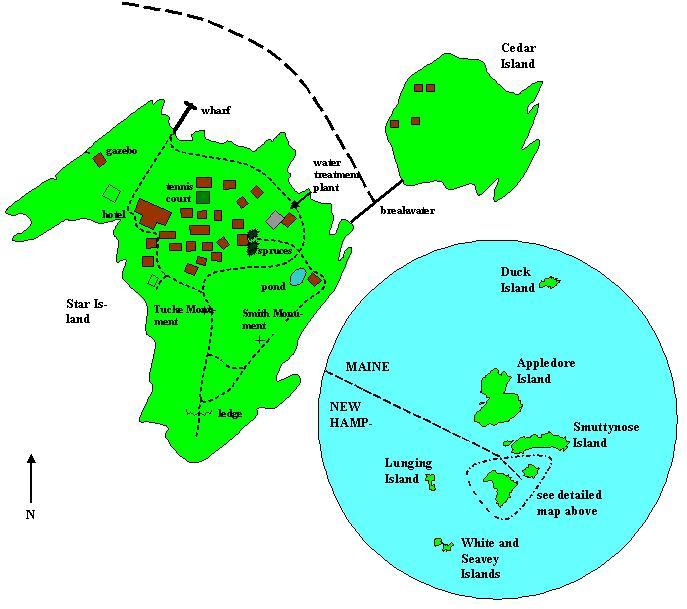Isles of Shoals--Appledore Island
Isles of Shoals--Appledore Island
Appledore Island, Maine
Official WebsiteVisit the Isles of Shoals (Yankee Magazine)
Pelagics and Whales (Maine Birding Trail)
eBird Pelagic Protocol
Maine Audubon Events Calendar
Tips for Birding
The Shoals Marine Laboratory schedules walking tours of Appledore Island.
About this Location
Appledore Island is the largest of the Isles of Shoals located about seven miles off the Maine coast. It is part of the Town of Kittery, in York County.
Appledore Island was originally settled by Europeans in the colonial era when the ease of transport by water made farming on the island economically efficient. A church was established in 1640. Near 1700, the entire settlement on this island moved to Star Island in New Hampshire to escape taxes imposed by Massachusetts (of which Maine was then a province).
The heyday of the island was the artists' salon that thrived there in the late 19th century, before the advent of artists' colonies as we know them today. Celia Thaxter reigned over an impressive group of friends who were also the leading artists, musicians, and writers of the day. These included Edward MacDowell and his wife; American pianist William Mason, son of Lowell Mason, who played the grand piano in her salon daily; and John Knowles Paine, America's first serious composer of note. Childe Hassam painted Celia's magnificent garden in a style similar to Monet's Giverny paintings. This rarefied atmosphere ended with Thaxter's death in 1894. The hotel burned in 1914, bringing down the final curtain on this heyday in American arts.
Today, the island is home to Shoals Marine Laboratory, run cooperatively by Cornell University and the University of New Hampshire since the early 1970s. Appledore Island is owned predominantly by the Star Island Corporation.
The most prominent feature on the island is a World War II concrete observation tower built to hold a radar installation. The dome intended to hold the radar no longer exists, and the radar unit was never installed.
About Isles of Shoals
See all hotspots at Isles of Shoals
The Isles of Shoals comprise a small archipelago that straddles the New Hampshire/Maine border about 5 miles off the coast. Star Island, Lunging Island, and White and Seavey Islands are the major islands in New Hampshire but are surrounded by plentiful small ledges. Like many islands off the coast, these can be very productive as migrant traps in spring and fall. Water birds are also plentiful around the islands year-round.
About Maine Pelagic Birding
See all hotspots at Maine Pelagic Birding
There are several different birding boat tours, whale watches, and pelagic trips that leave from Bar Harbor and other Maine ports. For pelagic trips, familiarize yourself with eBird's pelagic protocol and use the appropriate personal locations or eBird hotspots
The eBird pelagic protocol applies to checklists that are made farther than two miles offshore on oceans, seas, or large lakes. Choose the Pelagic Protocol option from the ‘Other’ menu of Observation Types. Please note that we still have much to learn about seabird distribution, so we encourage you to add photos and notes to document your sightings on your checklists!
If you’re moving: Count for up to 60 minutes on each checklist; stopping at the 1-hour mark. Record the distance traveled (ideally with eBird Mobile Tracks), adjust the distance estimate for backtracking as you would a traveling checklist, and choose a location on the map for where you started that checklist period. Repeat this process throughout the trip until you return to within two miles of shore.
If you’re anchored: Keep a checklist for as long as you’re anchored, and then follow the above instructions once you start to move again.
Great and Sooty Shearwaters often dominate the ocean during the second half of summer. Wilson's Storm-petrels can be abundant. Some of the world's biggest colonies of Leach's Storm-petrels also nest along the Maine coast, but their nocturnal habits make them difficult to find. In August, after breeding, they are sometimes seen in daylight from the whale-watch boats, especially off Acadia National Park. Bar Harbor Whale Watch is outstanding for pelagic species during its whale trips. Northern Gannets are frequent sights. Red and Red-necked Phalaropes gather offshore by the thousands later in summer.
A few Northern Fulmars are seen, and their numbers increase late in the season. Parasitic and Pomarine Jaegers are regularly seen from whale-watch boats, and a Long-tailed Jaeger is spotted in most years. Great and South Polar Skuas are seen sporadically and seem to be on the increase. All of the local alcid species are possible, especially in post-breeding dispersal.
Currently, the number of boat tours for pelagic birding in Maine is increasing. Maine Audubon offers the largest tour in autumn. Its annual trip on the Bar Harbor Whale Watch boats from Bar Harbor attracts birders from all over the world. In 2007, Maine Audubon began organizing additional trips to Matinicus Rock. Check the Event Schedule at Maine Audubon.
Northern Gannets, Black-legged Kittiwakes, Great and Sooty Shearwaters, Razorbills, and Common Murres are often seen from the Grand Manan ferry.
Features
Restrooms on site
Entrance fee
Wheelchair accessible trail
Content from Pelagics and Whales (Maine Birding Trail), eBird Pelagic Protocol, and Wikipedia
Last updated September 16, 2023
